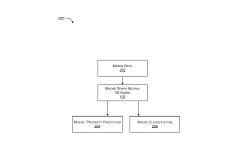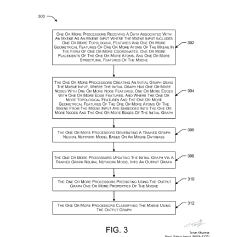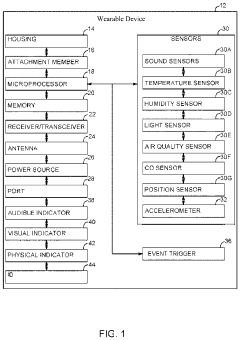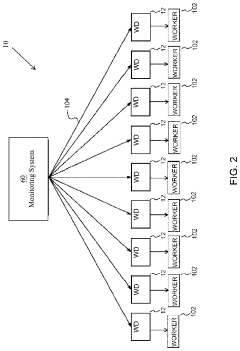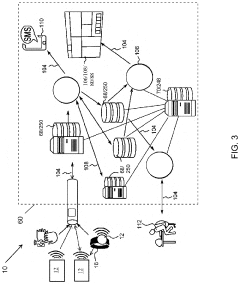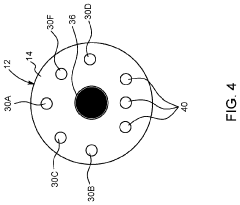MXene Contributions to Health Data Analytics Technology
AUG 8, 202510 MIN READ
Generate Your Research Report Instantly with AI Agent
Patsnap Eureka helps you evaluate technical feasibility & market potential.
MXene in Health Analytics: Background and Objectives
MXene, a class of two-dimensional transition metal carbides and nitrides, has emerged as a promising material in the field of health data analytics. Since its discovery in 2011, MXene has garnered significant attention due to its unique properties, including high electrical conductivity, large surface area, and excellent mechanical strength. These characteristics make MXene particularly suitable for applications in biosensing, wearable devices, and data processing systems, all of which are crucial components in modern health analytics.
The evolution of MXene technology in health data analytics has been driven by the increasing demand for more accurate, real-time, and personalized healthcare solutions. As the healthcare industry shifts towards data-driven decision-making and predictive analytics, there is a growing need for advanced materials that can enhance the performance of sensing devices and data processing systems. MXene's ability to integrate seamlessly with existing electronic systems while offering superior performance has positioned it as a key enabler in this technological transformation.
The primary objective of incorporating MXene into health data analytics is to improve the accuracy, speed, and efficiency of data collection and analysis. By leveraging MXene's unique properties, researchers aim to develop more sensitive biosensors capable of detecting minute changes in biological markers, thus enabling earlier disease detection and more precise health monitoring. Additionally, MXene-based wearable devices are being explored for their potential to provide continuous, non-invasive health monitoring, which could revolutionize preventive healthcare and chronic disease management.
Another critical goal is to enhance the processing capabilities of health data analytics systems. MXene's excellent electrical conductivity and potential for integration with other nanomaterials make it an ideal candidate for developing high-performance computing components. These advancements could lead to faster data processing, more complex analytical models, and ultimately, more accurate health predictions and personalized treatment plans.
Furthermore, the research community is focusing on exploring MXene's biocompatibility and long-term stability in biological environments. This is crucial for ensuring the safety and reliability of MXene-based health monitoring devices and implantable sensors. As the technology progresses, there is also a growing emphasis on developing scalable and cost-effective production methods for MXene, which is essential for its widespread adoption in healthcare applications.
In conclusion, the background and objectives of MXene in health analytics reflect a convergence of materials science, bioengineering, and data analytics. The overarching aim is to harness MXene's unique properties to create more advanced, efficient, and reliable health monitoring and data analysis systems. As research in this field continues to advance, MXene holds the potential to significantly contribute to the development of next-generation healthcare technologies, ultimately leading to improved patient outcomes and more personalized healthcare delivery.
The evolution of MXene technology in health data analytics has been driven by the increasing demand for more accurate, real-time, and personalized healthcare solutions. As the healthcare industry shifts towards data-driven decision-making and predictive analytics, there is a growing need for advanced materials that can enhance the performance of sensing devices and data processing systems. MXene's ability to integrate seamlessly with existing electronic systems while offering superior performance has positioned it as a key enabler in this technological transformation.
The primary objective of incorporating MXene into health data analytics is to improve the accuracy, speed, and efficiency of data collection and analysis. By leveraging MXene's unique properties, researchers aim to develop more sensitive biosensors capable of detecting minute changes in biological markers, thus enabling earlier disease detection and more precise health monitoring. Additionally, MXene-based wearable devices are being explored for their potential to provide continuous, non-invasive health monitoring, which could revolutionize preventive healthcare and chronic disease management.
Another critical goal is to enhance the processing capabilities of health data analytics systems. MXene's excellent electrical conductivity and potential for integration with other nanomaterials make it an ideal candidate for developing high-performance computing components. These advancements could lead to faster data processing, more complex analytical models, and ultimately, more accurate health predictions and personalized treatment plans.
Furthermore, the research community is focusing on exploring MXene's biocompatibility and long-term stability in biological environments. This is crucial for ensuring the safety and reliability of MXene-based health monitoring devices and implantable sensors. As the technology progresses, there is also a growing emphasis on developing scalable and cost-effective production methods for MXene, which is essential for its widespread adoption in healthcare applications.
In conclusion, the background and objectives of MXene in health analytics reflect a convergence of materials science, bioengineering, and data analytics. The overarching aim is to harness MXene's unique properties to create more advanced, efficient, and reliable health monitoring and data analysis systems. As research in this field continues to advance, MXene holds the potential to significantly contribute to the development of next-generation healthcare technologies, ultimately leading to improved patient outcomes and more personalized healthcare delivery.
Market Demand for MXene-Based Health Monitoring
The market demand for MXene-based health monitoring technologies is experiencing significant growth, driven by the increasing focus on personalized healthcare and the need for advanced wearable devices. MXenes, a class of two-dimensional transition metal carbides and nitrides, offer unique properties that make them highly suitable for health monitoring applications. These properties include excellent electrical conductivity, high surface area, and biocompatibility, which are crucial for developing sensitive and reliable health monitoring devices.
The global wearable health monitoring market, which includes MXene-based technologies, is projected to expand rapidly in the coming years. This growth is fueled by several factors, including the rising prevalence of chronic diseases, an aging population, and the increasing adoption of remote patient monitoring systems. MXene-based health monitoring devices are particularly well-positioned to address these market needs due to their ability to provide real-time, continuous health data with high accuracy and minimal invasiveness.
One of the key drivers of market demand for MXene-based health monitoring is the growing interest in preventive healthcare. Consumers are becoming more health-conscious and are seeking ways to proactively manage their well-being. MXene-based wearable devices offer the potential to track various health parameters, such as heart rate, blood pressure, glucose levels, and even stress indicators, empowering users to make informed decisions about their lifestyle and health management.
The healthcare industry is also showing increased interest in MXene-based health monitoring technologies. Hospitals and clinics are exploring ways to integrate these devices into their patient care systems to improve outcomes and reduce healthcare costs. The ability of MXene-based sensors to provide continuous, real-time data can help healthcare providers detect early signs of health issues and intervene promptly, potentially preventing more serious complications.
Another factor contributing to the market demand is the ongoing miniaturization and improvement in the performance of wearable devices. MXenes' unique properties allow for the development of ultra-thin, flexible, and highly sensitive sensors that can be seamlessly integrated into various form factors, from smartwatches to smart textiles. This versatility opens up new possibilities for health monitoring in diverse settings, including sports and fitness, workplace safety, and elderly care.
The COVID-19 pandemic has further accelerated the demand for remote health monitoring solutions, including those based on MXene technology. As healthcare systems worldwide seek to reduce in-person visits and monitor patients remotely, there is a growing need for reliable, easy-to-use health monitoring devices that can transmit data securely to healthcare providers.
Despite the promising market outlook, challenges remain in the widespread adoption of MXene-based health monitoring technologies. These include concerns about data privacy and security, the need for regulatory approvals, and the requirement for further research to validate the long-term safety and efficacy of MXene-based devices in various health monitoring applications. Addressing these challenges will be crucial for realizing the full market potential of MXene-based health monitoring technologies in the coming years.
The global wearable health monitoring market, which includes MXene-based technologies, is projected to expand rapidly in the coming years. This growth is fueled by several factors, including the rising prevalence of chronic diseases, an aging population, and the increasing adoption of remote patient monitoring systems. MXene-based health monitoring devices are particularly well-positioned to address these market needs due to their ability to provide real-time, continuous health data with high accuracy and minimal invasiveness.
One of the key drivers of market demand for MXene-based health monitoring is the growing interest in preventive healthcare. Consumers are becoming more health-conscious and are seeking ways to proactively manage their well-being. MXene-based wearable devices offer the potential to track various health parameters, such as heart rate, blood pressure, glucose levels, and even stress indicators, empowering users to make informed decisions about their lifestyle and health management.
The healthcare industry is also showing increased interest in MXene-based health monitoring technologies. Hospitals and clinics are exploring ways to integrate these devices into their patient care systems to improve outcomes and reduce healthcare costs. The ability of MXene-based sensors to provide continuous, real-time data can help healthcare providers detect early signs of health issues and intervene promptly, potentially preventing more serious complications.
Another factor contributing to the market demand is the ongoing miniaturization and improvement in the performance of wearable devices. MXenes' unique properties allow for the development of ultra-thin, flexible, and highly sensitive sensors that can be seamlessly integrated into various form factors, from smartwatches to smart textiles. This versatility opens up new possibilities for health monitoring in diverse settings, including sports and fitness, workplace safety, and elderly care.
The COVID-19 pandemic has further accelerated the demand for remote health monitoring solutions, including those based on MXene technology. As healthcare systems worldwide seek to reduce in-person visits and monitor patients remotely, there is a growing need for reliable, easy-to-use health monitoring devices that can transmit data securely to healthcare providers.
Despite the promising market outlook, challenges remain in the widespread adoption of MXene-based health monitoring technologies. These include concerns about data privacy and security, the need for regulatory approvals, and the requirement for further research to validate the long-term safety and efficacy of MXene-based devices in various health monitoring applications. Addressing these challenges will be crucial for realizing the full market potential of MXene-based health monitoring technologies in the coming years.
MXene Technology: Current State and Challenges
MXene, a class of two-dimensional transition metal carbides and nitrides, has emerged as a promising material in various fields, including health data analytics technology. The current state of MXene technology in this domain is characterized by rapid advancements and significant challenges.
MXene's unique properties, such as high electrical conductivity, large surface area, and excellent biocompatibility, have positioned it as a potential game-changer in health data analytics. Researchers have successfully demonstrated MXene's capabilities in biosensing, wearable electronics, and point-of-care diagnostics. These applications leverage MXene's ability to detect and analyze various biomarkers with high sensitivity and selectivity.
One of the key areas where MXene has shown promise is in the development of flexible and wearable sensors for continuous health monitoring. These sensors can collect real-time data on vital signs, physical activity, and even specific biomarkers, providing a wealth of information for health analytics. The integration of MXene-based sensors with data analytics platforms has opened up new possibilities for personalized healthcare and early disease detection.
However, several challenges remain in fully realizing MXene's potential in health data analytics technology. One significant hurdle is the scalability of MXene production. While lab-scale synthesis has been well-established, large-scale manufacturing processes that maintain the material's quality and properties are still under development. This limitation affects the widespread adoption of MXene-based devices in healthcare settings.
Another challenge lies in the long-term stability of MXene materials in physiological environments. Oxidation and degradation of MXene sheets can occur over time, potentially affecting the reliability and accuracy of health data collected by MXene-based sensors. Researchers are actively working on surface modification strategies and protective coatings to enhance MXene's stability without compromising its performance.
Data integration and interpretation present additional challenges. As MXene-based sensors generate vast amounts of health data, there is a need for advanced algorithms and data analytics tools to process and interpret this information effectively. Ensuring the accuracy, security, and privacy of health data collected through MXene devices is also a critical concern that needs to be addressed.
Despite these challenges, the current state of MXene technology in health data analytics is promising. Ongoing research efforts are focused on overcoming these obstacles, with significant progress being made in areas such as surface functionalization, composite formation, and device integration. As these challenges are addressed, MXene is poised to play an increasingly important role in revolutionizing health data analytics and personalized healthcare.
MXene's unique properties, such as high electrical conductivity, large surface area, and excellent biocompatibility, have positioned it as a potential game-changer in health data analytics. Researchers have successfully demonstrated MXene's capabilities in biosensing, wearable electronics, and point-of-care diagnostics. These applications leverage MXene's ability to detect and analyze various biomarkers with high sensitivity and selectivity.
One of the key areas where MXene has shown promise is in the development of flexible and wearable sensors for continuous health monitoring. These sensors can collect real-time data on vital signs, physical activity, and even specific biomarkers, providing a wealth of information for health analytics. The integration of MXene-based sensors with data analytics platforms has opened up new possibilities for personalized healthcare and early disease detection.
However, several challenges remain in fully realizing MXene's potential in health data analytics technology. One significant hurdle is the scalability of MXene production. While lab-scale synthesis has been well-established, large-scale manufacturing processes that maintain the material's quality and properties are still under development. This limitation affects the widespread adoption of MXene-based devices in healthcare settings.
Another challenge lies in the long-term stability of MXene materials in physiological environments. Oxidation and degradation of MXene sheets can occur over time, potentially affecting the reliability and accuracy of health data collected by MXene-based sensors. Researchers are actively working on surface modification strategies and protective coatings to enhance MXene's stability without compromising its performance.
Data integration and interpretation present additional challenges. As MXene-based sensors generate vast amounts of health data, there is a need for advanced algorithms and data analytics tools to process and interpret this information effectively. Ensuring the accuracy, security, and privacy of health data collected through MXene devices is also a critical concern that needs to be addressed.
Despite these challenges, the current state of MXene technology in health data analytics is promising. Ongoing research efforts are focused on overcoming these obstacles, with significant progress being made in areas such as surface functionalization, composite formation, and device integration. As these challenges are addressed, MXene is poised to play an increasingly important role in revolutionizing health data analytics and personalized healthcare.
Current MXene Solutions for Health Data Collection
01 Data analytics and processing for MXene materials
This category focuses on methods and systems for analyzing and processing data related to MXene materials. It includes techniques for data collection, storage, and analysis specific to MXene properties and applications. These methods can help researchers and engineers better understand and optimize MXene materials for various uses.- Data analytics and processing for MXene materials: This category focuses on methods and systems for analyzing and processing data related to MXene materials. It includes techniques for collecting, organizing, and interpreting data from various sources to gain insights into MXene properties, performance, and applications. These analytics tools can help researchers and engineers optimize MXene synthesis, characterization, and integration into various technologies.
- Machine learning and AI applications for MXene research: This point covers the use of machine learning and artificial intelligence techniques in MXene research and development. These advanced computational methods can be applied to predict MXene properties, optimize synthesis conditions, and discover new MXene compositions. Machine learning algorithms can analyze large datasets of MXene characteristics to identify patterns and correlations that may not be apparent through traditional analysis methods.
- Data visualization and user interface for MXene analytics: This category encompasses tools and methods for visualizing MXene-related data and creating user-friendly interfaces for data analysis. These solutions can help researchers and engineers better understand complex MXene data sets through interactive graphs, charts, and 3D visualizations. Improved data visualization can lead to more efficient decision-making in MXene research and development processes.
- Database management and integration for MXene research: This point focuses on the development and management of databases specifically designed for MXene research. It includes methods for organizing, storing, and retrieving large volumes of MXene-related data from various sources. These database solutions can facilitate collaboration among researchers, enable efficient data sharing, and support the integration of MXene data with other material science databases.
- Real-time data analytics for MXene production and applications: This category covers systems and methods for real-time data analytics in MXene production processes and applications. These solutions can provide immediate insights into synthesis parameters, quality control, and performance metrics. Real-time analytics can help optimize MXene production, improve efficiency, and enable rapid adjustments in research and manufacturing settings.
02 Machine learning and AI applications in MXene research
This point covers the use of machine learning and artificial intelligence techniques in MXene research and development. It includes algorithms and models for predicting MXene properties, optimizing synthesis processes, and identifying potential applications. These advanced analytics tools can accelerate the discovery and development of new MXene materials and applications.Expand Specific Solutions03 Visualization and data representation for MXene analytics
This category focuses on methods and systems for visualizing and representing data related to MXene materials. It includes techniques for creating interactive graphs, charts, and 3D models to better understand MXene structures and properties. These visualization tools can help researchers and engineers gain insights from complex MXene data sets.Expand Specific Solutions04 Database management and querying for MXene research
This point covers database systems and querying methods specifically designed for managing and accessing MXene-related data. It includes techniques for organizing, storing, and retrieving large volumes of MXene research data, as well as methods for integrating data from multiple sources. These systems can improve the efficiency and effectiveness of MXene research and development efforts.Expand Specific Solutions05 Collaborative platforms for MXene data sharing and analysis
This category focuses on collaborative platforms and tools that enable researchers and institutions to share and analyze MXene data collectively. It includes cloud-based systems, data sharing protocols, and collaborative analysis tools specific to MXene research. These platforms can facilitate knowledge exchange and accelerate advancements in MXene science and technology.Expand Specific Solutions
Key Players in MXene Health Analytics Research
The MXene contributions to health data analytics technology field is in its early development stage, with a growing market potential driven by increasing demand for advanced healthcare solutions. The technology's maturity is still evolving, with various players at different stages of research and development. Key companies like Murata Manufacturing Co. Ltd. and Guangzhou Yuemei Cloud Technology Co., Ltd. are exploring MXene applications in health data analytics, while academic institutions such as Qingdao University and Tongji University are conducting foundational research. The involvement of established healthcare technology firms like Cerner Innovation, Inc. and Optum, Inc. suggests growing industry interest, potentially accelerating the technology's development and commercialization in the near future.
The Regents of the University of California
Technical Solution: The University of California has made significant contributions to MXene-based health data analytics technology. They have developed a novel MXene-based biosensor platform for real-time health monitoring. This platform utilizes the unique properties of MXenes, such as high electrical conductivity and large surface area, to create highly sensitive and selective biosensors[1]. The researchers have demonstrated the ability to detect various biomarkers, including glucose, lactate, and specific proteins, with high accuracy and rapid response times[3]. Additionally, they have integrated these MXene sensors with flexible substrates, enabling wearable health monitoring devices that can continuously collect and analyze health data[5].
Strengths: High sensitivity and selectivity, real-time monitoring capabilities, potential for wearable applications. Weaknesses: Relatively new technology, may require further optimization for long-term stability and biocompatibility.
University of Florida
Technical Solution: The University of Florida has been at the forefront of MXene research for health data analytics. They have developed a MXene-based electrochemical sensing platform that can detect multiple biomarkers simultaneously. This multi-analyte sensing capability is achieved through the functionalization of MXene nanosheets with specific recognition elements[2]. The research team has also explored the use of MXenes in conjunction with machine learning algorithms to enhance the accuracy and reliability of health data analysis. By combining the high-performance sensing capabilities of MXenes with advanced data processing techniques, they have created a system that can provide more comprehensive and personalized health insights[4].
Strengths: Multi-analyte detection, integration with machine learning for improved data analysis. Weaknesses: Complexity of the system may present challenges for widespread adoption and commercialization.
Core Innovations in MXene Biosensing Technology
System and method for a graph neural network based regression and classification of mxenes
PatentPendingIN202341060539A
Innovation
- A Graph Neural Network (GNN) based system that processes MXene data by creating an initial graph with embedded topological and geometrical features, generating a trained model to predict properties and classify MXenes, using processors to receive and update the graph for efficient analysis and classification.
Nitrogen-sulfur co-doped ti3c2-mxene nanosheet and preparation method and application thereof
PatentPendingUS20230192555A1
Innovation
- A nitrogen-sulfur co-doped Ti3C2-MXene nanosheet with peroxidase-like activity is developed using a one-step method with thiourea doping, enabling efficient decomposition of hydrogen peroxide to produce hydroxyl radicals for colorimetric detection of uric acid, overcoming the limitations of step-by-step doping and secondary pollution.
Regulatory Considerations for MXene-Based Medical Devices
The integration of MXene-based technologies into medical devices presents a complex regulatory landscape that manufacturers and developers must navigate carefully. As these novel materials find applications in health data analytics and medical diagnostics, regulatory bodies such as the FDA in the United States and the EMA in Europe are closely scrutinizing their safety and efficacy profiles.
One of the primary regulatory considerations for MXene-based medical devices is their classification. Depending on the intended use and risk level, these devices may fall under different regulatory categories, each with its own set of requirements. For instance, a MXene-based biosensor for continuous glucose monitoring might be classified as a Class II medical device, requiring a 510(k) premarket notification in the US.
Safety and biocompatibility are paramount concerns for regulators. Manufacturers must provide comprehensive data on the long-term effects of MXene materials when in contact with human tissues or bodily fluids. This includes cytotoxicity studies, genotoxicity assessments, and evaluation of potential inflammatory responses. The unique properties of MXenes, such as their high electrical conductivity and surface chemistry, necessitate specialized testing protocols to ensure their safety in medical applications.
Performance validation is another critical aspect of the regulatory process. Developers must demonstrate that MXene-based devices can consistently and accurately perform their intended functions in health data analytics. This involves rigorous testing under various environmental conditions and comparison with existing gold standard methods. Regulators will likely require clinical studies to validate the performance of these devices in real-world settings.
Data privacy and security are increasingly important considerations, especially for MXene-based devices that collect and transmit health data. Manufacturers must implement robust cybersecurity measures and comply with regulations such as HIPAA in the US or GDPR in Europe to protect patient information. This includes secure data encryption, user authentication protocols, and measures to prevent unauthorized access or data breaches.
Quality control and manufacturing processes are subject to strict regulatory oversight. Good Manufacturing Practices (GMP) must be adhered to, with particular attention to the unique challenges posed by MXene production and integration into medical devices. This includes establishing consistent synthesis methods, ensuring batch-to-batch reproducibility, and implementing rigorous quality assurance protocols.
As MXene technology is relatively new in the medical field, regulators may require post-market surveillance studies to monitor long-term safety and efficacy. Manufacturers should be prepared to conduct ongoing assessments and report any adverse events or device malfunctions promptly to regulatory authorities.
One of the primary regulatory considerations for MXene-based medical devices is their classification. Depending on the intended use and risk level, these devices may fall under different regulatory categories, each with its own set of requirements. For instance, a MXene-based biosensor for continuous glucose monitoring might be classified as a Class II medical device, requiring a 510(k) premarket notification in the US.
Safety and biocompatibility are paramount concerns for regulators. Manufacturers must provide comprehensive data on the long-term effects of MXene materials when in contact with human tissues or bodily fluids. This includes cytotoxicity studies, genotoxicity assessments, and evaluation of potential inflammatory responses. The unique properties of MXenes, such as their high electrical conductivity and surface chemistry, necessitate specialized testing protocols to ensure their safety in medical applications.
Performance validation is another critical aspect of the regulatory process. Developers must demonstrate that MXene-based devices can consistently and accurately perform their intended functions in health data analytics. This involves rigorous testing under various environmental conditions and comparison with existing gold standard methods. Regulators will likely require clinical studies to validate the performance of these devices in real-world settings.
Data privacy and security are increasingly important considerations, especially for MXene-based devices that collect and transmit health data. Manufacturers must implement robust cybersecurity measures and comply with regulations such as HIPAA in the US or GDPR in Europe to protect patient information. This includes secure data encryption, user authentication protocols, and measures to prevent unauthorized access or data breaches.
Quality control and manufacturing processes are subject to strict regulatory oversight. Good Manufacturing Practices (GMP) must be adhered to, with particular attention to the unique challenges posed by MXene production and integration into medical devices. This includes establishing consistent synthesis methods, ensuring batch-to-batch reproducibility, and implementing rigorous quality assurance protocols.
As MXene technology is relatively new in the medical field, regulators may require post-market surveillance studies to monitor long-term safety and efficacy. Manufacturers should be prepared to conduct ongoing assessments and report any adverse events or device malfunctions promptly to regulatory authorities.
Ethical Implications of MXene in Healthcare
The integration of MXene in healthcare data analytics brings forth significant ethical considerations that must be carefully addressed. As this advanced material enhances the capabilities of health monitoring and data processing, it raises important questions about privacy, data security, and equitable access to healthcare technologies.
One primary ethical concern is the potential for increased surveillance and intrusion into personal health information. MXene-based sensors and devices can collect vast amounts of sensitive health data, which may lead to concerns about unauthorized access or misuse of this information. Healthcare providers and technology developers must implement robust data protection measures and adhere to strict privacy regulations to safeguard patient confidentiality.
The accuracy and reliability of MXene-enhanced health analytics also present ethical challenges. While these technologies offer improved diagnostic capabilities, there is a risk of over-reliance on automated systems, potentially leading to misdiagnosis or inappropriate treatment decisions. It is crucial to maintain a balance between technological advancements and human expertise in healthcare decision-making processes.
Equity and accessibility issues arise as MXene-based healthcare technologies become more prevalent. There is a risk of creating or exacerbating healthcare disparities if these advanced tools are not equally available to all populations. Ensuring fair distribution and access to MXene-enhanced healthcare solutions is essential to prevent widening the gap between those who can afford cutting-edge treatments and those who cannot.
The use of MXene in health data analytics also raises questions about informed consent and patient autonomy. As these technologies become more sophisticated, patients may struggle to fully understand the implications of sharing their health data or the extent of information being collected. Healthcare providers must develop clear communication strategies to ensure patients are well-informed and can make autonomous decisions about their health data.
Ethical considerations extend to the long-term effects of MXene-based health monitoring. Continuous health tracking may lead to increased anxiety or obsessive behavior in some individuals. Additionally, there are concerns about the potential for discrimination based on health data, particularly in areas such as insurance or employment. Safeguards must be put in place to prevent such misuse of health information.
As MXene technology advances, it is imperative to establish comprehensive ethical guidelines and regulatory frameworks. These should address data ownership, transparency in algorithms used for health analytics, and the responsible development and deployment of MXene-based healthcare solutions. Ongoing dialogue between technologists, healthcare professionals, ethicists, and policymakers is crucial to navigate the complex ethical landscape of this emerging technology.
One primary ethical concern is the potential for increased surveillance and intrusion into personal health information. MXene-based sensors and devices can collect vast amounts of sensitive health data, which may lead to concerns about unauthorized access or misuse of this information. Healthcare providers and technology developers must implement robust data protection measures and adhere to strict privacy regulations to safeguard patient confidentiality.
The accuracy and reliability of MXene-enhanced health analytics also present ethical challenges. While these technologies offer improved diagnostic capabilities, there is a risk of over-reliance on automated systems, potentially leading to misdiagnosis or inappropriate treatment decisions. It is crucial to maintain a balance between technological advancements and human expertise in healthcare decision-making processes.
Equity and accessibility issues arise as MXene-based healthcare technologies become more prevalent. There is a risk of creating or exacerbating healthcare disparities if these advanced tools are not equally available to all populations. Ensuring fair distribution and access to MXene-enhanced healthcare solutions is essential to prevent widening the gap between those who can afford cutting-edge treatments and those who cannot.
The use of MXene in health data analytics also raises questions about informed consent and patient autonomy. As these technologies become more sophisticated, patients may struggle to fully understand the implications of sharing their health data or the extent of information being collected. Healthcare providers must develop clear communication strategies to ensure patients are well-informed and can make autonomous decisions about their health data.
Ethical considerations extend to the long-term effects of MXene-based health monitoring. Continuous health tracking may lead to increased anxiety or obsessive behavior in some individuals. Additionally, there are concerns about the potential for discrimination based on health data, particularly in areas such as insurance or employment. Safeguards must be put in place to prevent such misuse of health information.
As MXene technology advances, it is imperative to establish comprehensive ethical guidelines and regulatory frameworks. These should address data ownership, transparency in algorithms used for health analytics, and the responsible development and deployment of MXene-based healthcare solutions. Ongoing dialogue between technologists, healthcare professionals, ethicists, and policymakers is crucial to navigate the complex ethical landscape of this emerging technology.
Unlock deeper insights with Patsnap Eureka Quick Research — get a full tech report to explore trends and direct your research. Try now!
Generate Your Research Report Instantly with AI Agent
Supercharge your innovation with Patsnap Eureka AI Agent Platform!

